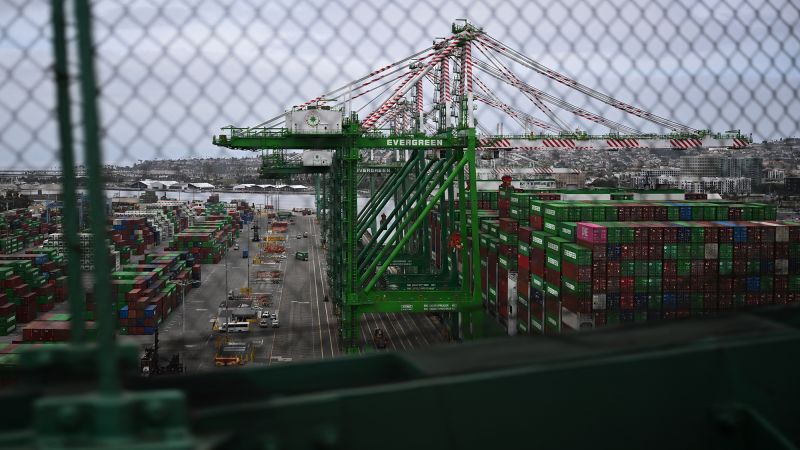In the spring of 2023, the economic landscape of the United States took a notable downturn, primarily attributed to significant policy shifts initiated by President Donald Trump. These abrupt changes had pervasive implications for both consumers and businesses, leading to a considerable slowing of the economy that many experts worried might reflect the worst quarter the country had experienced since the onset of the Covid-19 pandemic. The major concerns revolved around the imposition of extensive tariffs, which created uncertainty and anxiety across various sectors.
The upcoming report from the Commerce Department scheduled for Wednesday at 8:30 am ET was anticipated to shed light on the nation’s economic standing, revealing the first estimate for the gross domestic product (GDP) in the first quarter. This crucial report would serve as a significant indicator of how Trump’s aggressive economic strategies were influencing overall economic performance, coinciding with the first 100 days of his term. Analysts and economists were keenly awaiting these numbers, as they could provide initial insights into the implications of various fiscal policies that had generated considerable discussion and speculation.
Economists forecasted that the GDP growth for the first quarter would sit at an annualized rate of around 0.8%, which, if accurate, would mark the weakest performance since the second quarter of 2022. Notably, the Federal Reserve Bank of Atlanta had a more pessimistic outlook, predicting a substantial contraction of approximately 2.5%. Such outcomes would indicate a regression not seen since the economic recovery post-pandemic had begun in earnest. A variety of factors were likely influencing these projections, including increased imports as American consumers scrambled to evade the new tariffs, a slowdown in consumer spending spurred by severe weather, and companies delaying investments amid uncertainty over forthcoming policy decisions.
Nathan Sheets, Citigroup’s global chief economist, acknowledged the chaotic nature of the current economic data, stating, “There’s a lot of noise in the data from storms, people front-loading, and some payback for the strength in the fourth quarter.” Sheets further pointed out that the uncertainty from the tariffs was creating a considerable economic cloud, making it challenging for both businesses and consumers to navigate future spending confidently.
The Trump administration’s aggressive tariff policy was characterized by significant levies, including 25% tariffs on aluminum and steel, as well as similar rates on goods from Mexico and Canada that failed to meet trade agreement standards. Moreover, an extraordinary 145% duty was imposed on Chinese imports, with an additional 25% tariff slated for cars and auto parts. There was also a blanket baseline tariff of 10% on all imports. These tariffs were instituted in response to what Trump termed a “national emergency” regarding the trade deficit, which paradoxically continued to worsen.
April 9 saw the brief announcement of a massive surcharge on numerous countries, only to be promptly delayed until July, reflecting the administration’s turbulent approach to international trade. Subsequent exemptions for specific electronic goods were introduced, alongside Trump’s notes regarding pending tariffs on critical sectors such as semiconductors, pharmaceuticals, and timber. China’s reciprocal actions included escalating its tariffs on U.S. imports to an unprecedented 125%, while both the European Union and Canada expressed their commitment to contest these U.S. tariffs vigorously.
Despite Trump’s efforts, the trade deficit was exacerbated during the early days of his second term, with a staggering 34% increase in January, reaching $130.6 billion—the highest figure noted since 1994. While there was a slight contraction to $122.7 billion in February, it still marked the second-largest deficit on record. Nicole Cervi, an economist at Wells Fargo, commented on the drivers of this widening trade gap, attributing it primarily to rising costs associated with industrial supplies and consumer goods.
As the economic mood softened and consumer confidence dipped, economists observed notable changes in spending behaviors. A combination of adverse weather conditions and external factors led to a reduction in consumer spending at the start of the year, while a temporary spike in March suggested that many consumers rushed to make purchases before the tariffs could take effect. This pattern demonstrates the complexities and unpredictable nature of consumer behavior in response to government policy shifts.
In conclusion, the unique challenges presented during the early months of 2023 reflect a critical juncture in U.S. economic policy driven by President Trump’s tariff initiatives. These changes have resulted in notable volatility and uncertainty, which, combined with various external factors, contributed to a significant slowing of the economy. The outcome of these developments will be keenly analyzed as new economic reports emerge, painting a clearer picture of America’s economic trajectory.



